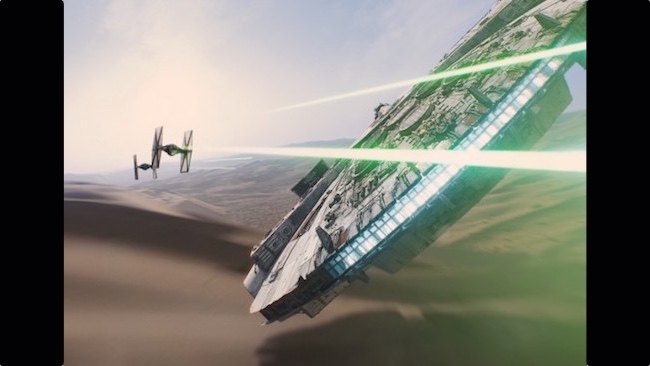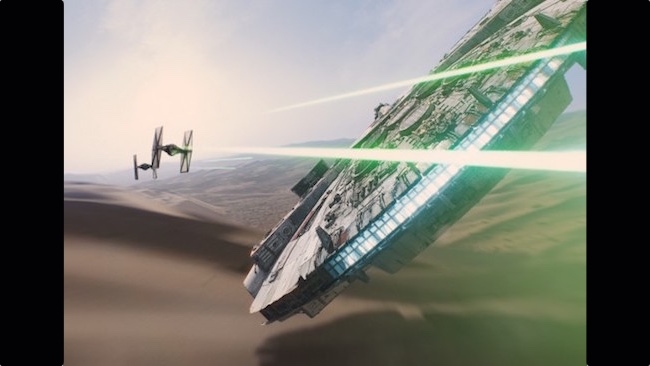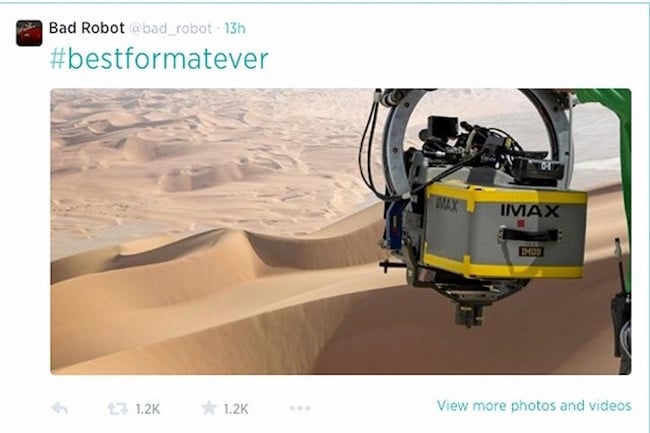
 1.43:1 in all its glory
1.43:1 in all its glory
Cineasts have always had a thing for the big seven zero, but Star Wars: The Force Awakens’ arrival on IMAX screens this December highlights how few screens nowadays are capable of delivering the genuine 70mm experience.
Recently, 70mm has been bandied around as a selling point for movies in much the same way as as stereo 3D, IMAX, HD and Blu-ray have been in the past - another buzzword implying a superior viewing experience worthy of a higher price tag. Christopher Nolan, Paul Thomas Anderson and now Quentin Tarantino are all doing their bit to extol the virtues of the largest prestige format of them all.
Amidst all the hoopla it’s easy to forget that 70mm has been around as long as cinema itself - indeed the first 70mm film was recorded and projected in the 1890s. But while 70mm has always been regarded as a gold standard for cinema - enjoying greatest success in the 1970s fightback against television via showcase works including Lawrence of Arabia - in truth it’s never been a practical mainstream option.
Each successive 70mm technology has relied on equipment larger, more cumbersome and more expensive than 35mm alternatives. 70mm cameras are still so big and heavy as to be impractical in many situations. The film itself is (almost) twice as wide and so involves eight times the amount of silver halide in the emulsion*, so the reel itself is heavier and pricier - a single fresh print of Lawrence was estimated to cost over $70,000, while projectionists had to deal with 600lbs of celluloid (49 reels in total) for a 70mm IMAX showing of Interstellar. The projection systems, meanwhile, not only need to be able to smoothly feed that film past the lens, they also need to do so without degrading that expensive reel and project with a clarity that will pass muster when the images are thrown onto supersized cinema screens. The beauty of 70mm cameras is that they capture moving images in more detail and with greater colour accuracy, but this means that only well-maintained 70mm projectors will output that footage with optimal stability and crispness.
Cleverly, IMAX has steadily become the 70mm champion by making a virtue of this niche status, a position bolstered by the fact that only a handful of independent cinemas worldwide now possess classic 70mm projection equipment. To watch an IMAX performance is to enjoy cinema at its biggest and best. The fact that there are a relatively small number of IMAX-equipped venues in the world and that customers are charged a premium price only adds to the cachet.
When is IMAX not IMAX?
Or at least that’s the idea. IMAX rose to fame on the back of a proprietary 15/70mm format, one with an aspect ratio of 1.43:1 that runs the film horizontally through the projector alongside a separate audio track to deliver resolution superior even to the older 70mm formats such as Super Panavision (and around ten times the resolution of standard 35mm). In truth, many of the film releases that helped turn IMAX from a company focused on museums and ‘experiences’ to a Hollywood-friendly one were simply upscaled from 35mm to 70mm using IMAX’s Digital Media Remastering system.
And more crucially, the IMAX name is now used to denote lower-specced offerings. There are many times more IMAX screens than a decade ago, but most don’t use 70mm projects at all, but rather the IMAX Digital system introduced in 2008, which utilises two 2K Christie projectors. Even some venues that previously worked with the 15/70mm format have since switched to the inferior digital technology.
Even worse, many auditoriums have simply been retrofitted with IMAX Digital projectors, so the projection screens measure a paltry 8.5x18 metres in comparison to the 23x30 metre screens used in ‘true’ IMAX 70mm auditoriums. In the past the company has made no distinction in marketing or ticket price between the vastly different setup, so many cinemagoers have been left completely in the dark. IMAX critics have dubbed the retro-fitted Digital option ‘LieMAX’. At the very least it’s an unwelcome sleight of hand that actually diminishes the key selling point of the IMAX brand.
It also obviously has huge implications for filmmakers. When Christopher Nolan became the first Hollywood director to actually utilise a 70mm IMAX camera, shooting 28 minutes of footage for 2008’s The Dark Knight (the rest of the film was upscaled) it proved so successful that IMAX screens accounted for 10% of US box office receipts, despite only accounting for 1/46th of all screens. That should have helped encourage more 70mm content, but ironically, it was this success that helped IMAX push into multiplexes with its lower quality variants.
When it came to the 2014 release of Nolan’s Interstellar, featuring over an hour of 70mm IMAX footage, the marketing campaign even went so far as to give American cinemagoers an online cinema reference guide. It revealed that just 40 venues in the US were showing the film as the director intended. In the UK, there were just three venues left capable of running the 70mm version, and one of those - at the Odeon Leicester Square - necessitated the rebuild of an unused 16-year-old projection system using spare parts.

It gets worse. That same year, a tweet from JJ Abrams’ production company Bad Robot revealed that the director was using an IMAX camera to shoot a key Millennium Falcon sequence for Star Wars: The Force Awakens. The tweet’s accompanying hashtag was #bestformatever. In fact, just 18 IMAX-branded cinemas in the US (out of around 400) will be screening this bit of footage as it was shot. Many locations that previously screened Interstellar in 70mm are instead going to project digitally. In the UK, it’ll be shown in 70mm at just one venue: London’s Science Museum.
Laser to the rescue?
There are three reasons for this drop in numbers. One is that many ‘classic’ IMAX cinemas have ditched the expensive, cumbersome and little-utilised 70mm equipment altogether. Then there’s the fact that Disney is pushing Star Wars in the more profitable post-converted digital 3D flavour (by contrast Interstellar was 2D only), and is rumoured to be producing only a handful of 70mm prints. Finally, IMAX is starting to roll out its new ‘IMAX with Laser’ system. Featuring two 4K projectors this offers a cost-effective alternative to 70mm and can also screen stereo 3D, but the problem is just seven screens in the US currently have it. Some other venus have removed their 70mm projectors in readiness for an upgrade, but still don’t have the new technology in place.
Clearly, 70mm is in a bad place right now. There’s almost no way to get it in front of audiences and so little reason for filmmakers to even consider trying to revive the long-revered format. The IMAX with Laser system does offer some hope, however. Purists may balk at the notion of using a digital projection system for playback of analogue film, despite’s IMAX’s claims that “with laser, we have a solution that can meet or exceed IMAX film”. But early word is positive and the system does offer some unique advantages. Colour reproduction and contrast is better than 70mm IMAX, while the six feet high by six feet wide projectors cast an image around 60% brighter than a standard film projector. And while the resolution is effectively slightly lower than that offered by 70mm, the system’s 100 lasers and 800,000 mirrors provide a unique degree of clarity. Handily, it also preserves the familiar 1.43:1 aspect ratio.
Currently some 71 venues around the globe have signed up for IMAX with Laser. At the moment it only works with the larger IMAX screens, though the company is also working on a version that can be rolled out into those smaller venues. While that inevitably means a two-tier system will remain, it will at least help make high quality digital distribution of 70mm-shot footage easier (including support for stereo 3D releases). Compound that with the massive savings digital distribution offers over physical IMAX reels and movie studios suddenly have much greater incentive to support 70mm filmmaking. We should have a better notion just how much of an impact it makes by mid-2017… coincidentally around the same time Star Wars: Episode VIII comes crashing into cinemas.
*We asked Mark to check those figures. This is what he said:
"While the IMAX 70mm is often referred to as being double the width, so you might think it's just double the amount of silver halide, there’s actually more to it than that. Because 35mm film also contains the audio track (whereas all the film on IMAX is for the image) there’s an even bigger difference in the frame width. What’s more, the height of each frame is also significantly larger.
So, 35mm Academy Format is 21.95mm x 18.6mm (408.27mm2) with 4 perforations running along the height, whereas IMAX 70mm is 70mm x 48.5mm (3395mm2) with 15 perforations running horizontally.
So it's actually more than eight times the area, not twice.
Then of course, there are other 35m variations beyond ‘Academy Format’, with subtle differences in height, width and area, so the figure becomes a bit wavy..."
Tags: Production



Comments